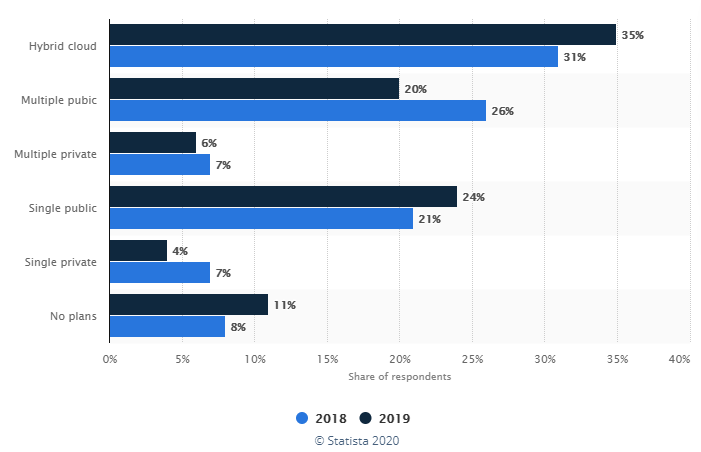Businesses and organisations of all sizes are embracing cloud computing. Small and medium sized businesses have decided that they don’t want to be left out of the party.
The figure below shows the type of cloud model that small and medium sized businesses are implementing on a world-wide basis:

Figure 1- Small and medium-sized business cloud strategy worldwide in 2018 and 2019, by cloud type.
From the chart there is a clear trend towards adopting public cloud services and often integrating with on-premise services into a hybrid cloud configuration.
The reasons that organisations are adopting the cloud are as varied as they are. Often their motivation is one or a combination of factors that include:
- Technological Innovation – Many organisations struggle just keeping the systems they have running. They lack the capacity to implement new capabilities or deliver innovation. The cloud can be an on-ramp to access the types of capabilities that cannot be provided easily using their existing approach.
- Capacity – Smaller organisations do not have the luxury of having spare capacity “just in case.” This can lead to lengthy delays to provide it, and scarce business opportunities can slip by.
- Access to Applications – There is a wide variety of application software that is available from the cloud, and in some cases only from the cloud. Businesses looking to avoid the cost and time of an application implementation can short circuit the process by using a cloud delivered Software as a Service option.
- Implementation speed – There is an attraction to the ability to create servers and databases on the fly. This allows ideas and directions to be tried without significant costs or delays. Test infrastructure is often one of the early workloads that are cloud deployed.
Cloud adoption has challenges for even the most adept businesses. Whilst the benefits are enormous, many organisations struggle with both technical and business issues.
Some of the common challenge are:
Network Integration
There is some underlying infrastructure plumbing that needs to be in place to access and integrate a cloud service into an organisation. This is true even when not implementing a hybrid cloud model. Consideration needs to be paid to details like firewalls and name resolution services.
Identity Integration
How does a business identify its users and manage permissions in the cloud? Do they maintain both a cloud native identity and an internal one? Managing the identity challenge is an area that needs planning and attention during cloud adoption.
Roles and Responsibilities
There are more than just ‘technical’ issues to be addressed in a journey to the cloud. Roles and responsibilities are clear for the current environment but need to be defined, often for the same function but performed in the cloud. There are also new roles that need to be defined and assigned.
Budgeting
One of the biggest challenges that organisations have is how to budget for cloud services. Infrastructure and services that used to accounted for as a capital expenditure, are now operational expenses. This can have a significant impact on an organisations budgeting process.
Communication
Like all technology projects, a cloud adoption project needs to have frequent and clear communications. Stakeholders need to understand and buy-in to the migration. End-users and IT staff need to understand what the changes mean to them. The timelines need to be as well communicated as possible.
Where does all this lead? The takeaway message is that adopting a cloud model has the potential to deliver enormous business benefits and should be evaluated by those that have not yet made the leap. Secondly, having a partner who can guide you through the process – from feasibility and assessment to migration and maintenance – is extremely valuable and a must-have on your cloud strategy.
As a partner Jupiter Group has the experience and capability to assist business in this journey. Get in touch today for more information on how we can help.


